Authentic German Springerle Cookies
This post may contain affiliate links. See my disclosure policy.
Springerle are German anise-flavored cookies that go back at least 700 years in their rich tradition as special gifts during the holidays and other celebrations. Delicately crispy-crunchy and a slightly chewy center, they’re made with simple ingredients and are easy to make but absolutely require that you follow some key steps to achieving the right look, texture and flavor. This authentic Springerle cookies recipe goes back to the Swabia region of Germany where these famous cookies originated.
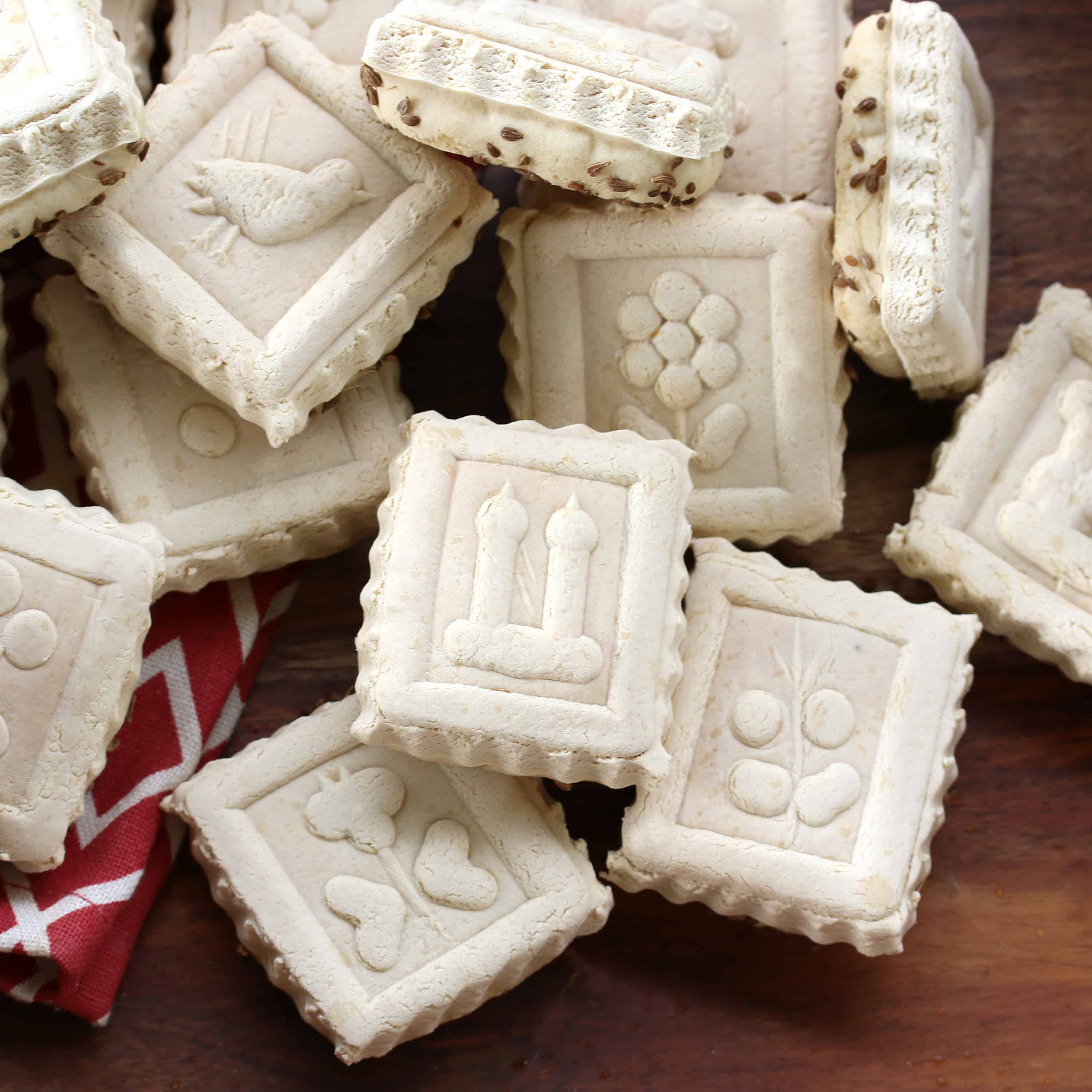
What Are Springlere Cookies?
Springerle are traditional German cookies with a very long, very rich history and tradition and come from the Swabia region of southern Germany where I’m from. They’re delicately flavored with anise and are embossed with a variety of designs. Historically made for religious holidays and other special occasions, today they are most commonly made during the Christmas season and for New Year’s though Springerle with flowers, landscapes and other everyday designs remain popular throughout the year. The name “Springerle” translates from German as “little jumpers” because of their behavior of rising or “jumping up” while they’re baking.
Authentic Springerle are made with eggs, sugar, flour, baker’s ammonia, salt and anise. They’re a very low-moisture cookie that are made without any fat. Springerle are very hard cookies that are stored long-term to undergo a period of “ripening” for several weeks as their flavor and texture develops. Over time they develop a delicately crispy-crunchy, shattering exterior and a slightly chewy center. They are traditionally eaten with and dunked in a hot beverage.
The hallmark of Springerle lies in the beauty of their presentation created by special molds used to emboss designs on their surface. Springerle were traditionally made as gifts, as charms for happiness, to give to friends and loved ones on special occasions such as births, weddings, betrothals, during the Christmas season and on New Year’s.
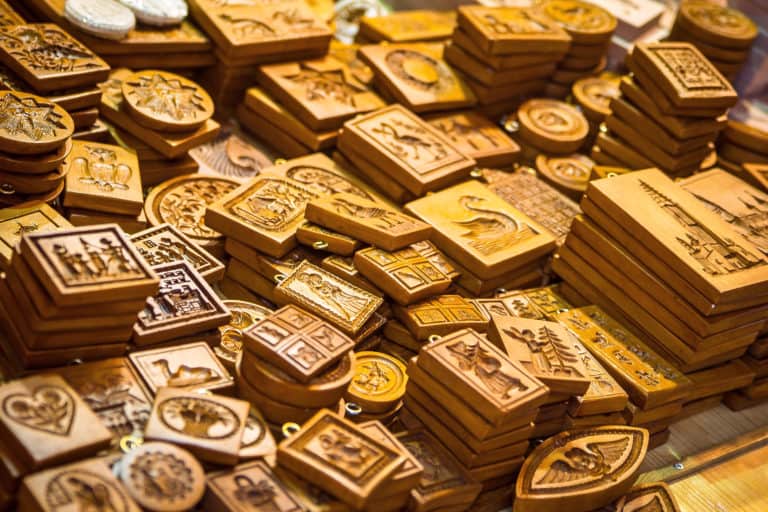
A Brief History of Springerle Cookies
These renowned cookies can be traced back to at least the 1300’s to the Swabia region of southern Germany where they were regarded as charms for good luck, happiness and religious observance. Historically Springerle molds were a German baker’s opportunity to show off his woodcarving skills. At that time baking apprentices in Swabia Germany not only had to demonstrate their ability to bake, they also had to carve their own Springerle molds as a kind of rite of passage to becoming a full-fledged, bona fide baker. The more intricate and detailed the mold, the more heralded the baker. These molds were passed down from generation to generation as treasured family heirlooms.
In fact, so prized were these family heirlooms that Germans immigrating to the United States in the 17th and 18th centuries would make space in their luggage just for their Springerle molds.
The themes of the Springerle molds changed throughout the centuries, transitioning from the earlier religious symbols in the 15th century to scenes of gallantry with knights on horseback, then on to the more romantic and highly detailed images of the 19th century with flowers, landscapes, and symbols of love, marriage and friendship. In the 20th century designs included things like Santa Claus, reindeer, and Christmas trees.
You can still buy both simple and elaborate wood-carved Springerle molds in Germany and you can also find antique ones that usually command a hefty price, especially the very detailed ones.
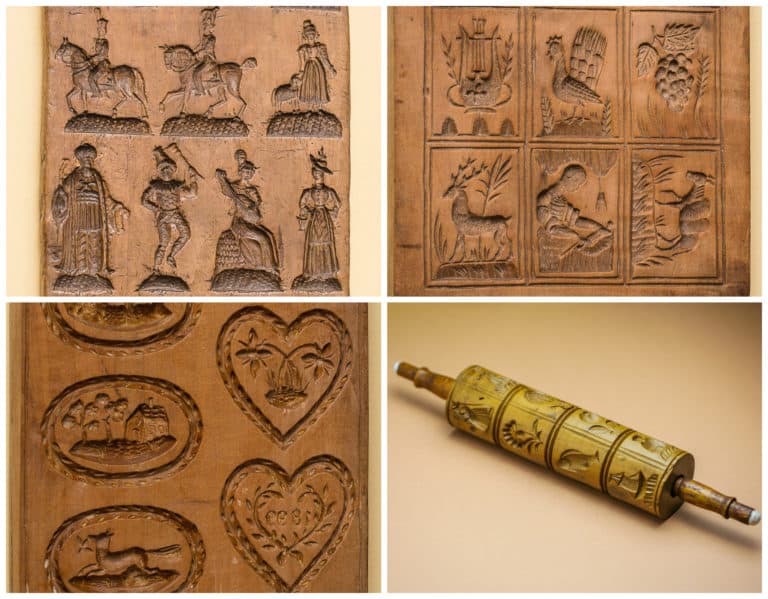
Special Equipment: Springerle Cookie Molds
Trying to find Springerle molds outside of Germany and other European countries that make cookies using molds (eg, Belgium and the Netherlands’ well-known speculoos/speculaas cookies), is very challenging. You can buy antique molds on eBay at a premium price or you can just use whatever you have that’s available. For example, you can use cookie stamps. There are a number of inexpensive ones on the market as well as high quality ones like these cookie stamps from Nordic Ware that are built to last and whose designs are cut deep enough to make a good impression on the cookie (Nordic Ware has multiple designs to choose from). I have three different sets of Nordic Ware cookie stamps.
Pictured below is my Springerle rolling pin that I brought with me from Stuttgart, Germany before I moved to the U.S.. This is the mold that I used in the pictures for this recipe. A Springerle rolling pin is easy to use and you can crank out a ton of Springerle very quickly. Amazon has a hand-carved Springerle rolling pin that looks similar to mine.
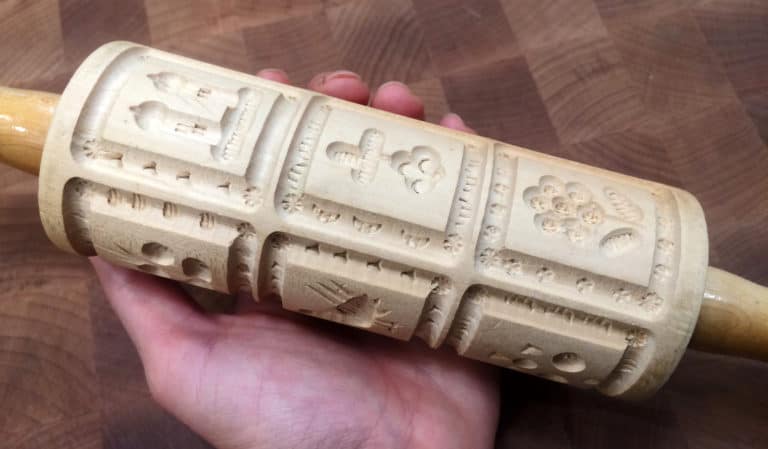
How to Make Authentic Springerle Cookies
I’m going to share 5 keys with you, 5 essential elements, for making authentic German Springerle.
Key #1 to Making Authentic Springerle: Baker’s Ammonia
Ammonium bicarbonate, known as baker’s ammonia, is an old-fashioned leavening agent that was commonly used until the 19th century when baking soda and baking powder came onto the scene. If you look through very old cookbooks you’ll find baker’s ammonia in the list of ingredients for specific kinds of baked goods. And while baking powder and baking soda largely replaced and perform a similar function to baker’s ammonia, they are not one and the same. In Europe and the Middle East, for example, some recipes for low-moisture things like crackers and crispy cookies still call for baker’s ammonia because of its unique qualities that baking powder or baking soda cannot replicate. It’s also used (either that or potash) for other types of “flat” baked goods such as German Lebkuchen, Honigkuchen and a German pastry known as Amerikaner, to “loosen” the texture of their crumb.
Springerle are the perfect example of a baked good that really requires the use of baker’s ammonia to get the right results and that’s traditionally what they were always made with.
It doesn’t matter which brand you use, but select one that’s food grade. I’ve been using organic food grade Baker’s Ammonia from Pure Organics.
*Just a note of warning: Baker’s ammonia smells BAD. Really bad. But don’t worry, the smell dissipates during baking.
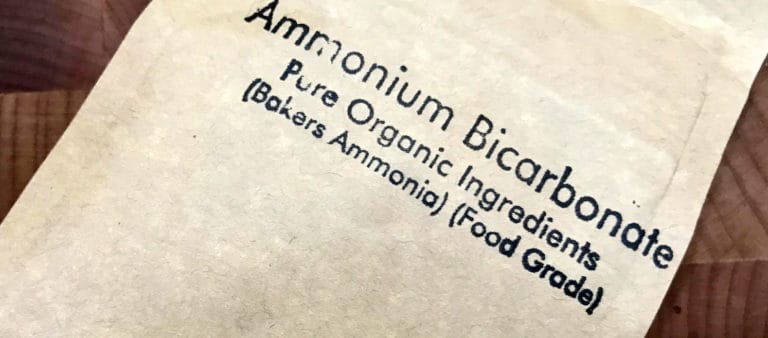
Baker’s Ammonia vs. Baking Powder vs. Baking Soda
Besides having different chemical compositions, they perform differently. While all three are leavening agents, baker’s ammonia creates an effect that baking powder and soda cannot replicate. As the cracker or cookie is baking, the tiny crystals in the ammonium bicarbonate break down and leave tiny air pockets behind in the crumb. The best way to describe the effect is that baker’s ammonia creates a unique honey-combed, porous crumb so that hard baked goods like crackers and cookies/biscuits have a more delicate, crispier, crunchier texture. Baker’s ammonia also contributes to a more even spread of the cookies.
Baker’s ammonia does have a very strong, very unpleasant odor but don’t be put off by that – the odor and taste will dissipate during baking.
In contrast what you normally get with a baked good that has virtually no moisture in it is something you could break your tooth on or could serve as a door stopper. (Think military hard tack from generations ago. Soldiers had to dip it in their coffee in order to make it edible.)
THAT is what you get if you make Springerle without baker’s ammonia: Rock hard, tooth-breaking, door-stopping cookies.
But let’s also be clear on something: Springerle are meant to be hard. And they’re traditionally eaten with a hot beverage for dipping. But the difference is that the baker’s ammonia creates that honey-combing effect that makes them less dense and gives them a more delicate and crunchy crumb.
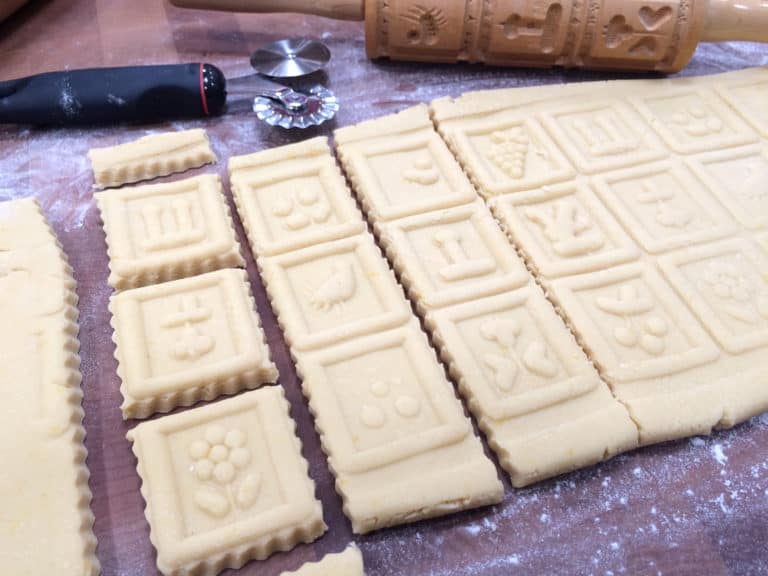
In addition to the texture advantage of using baker’s ammonia for low-moisture, crispy goods, it also doesn’t leave behind the characteristic soapy flavor that baking powder or soda does.
Cook’s Illustrated’s verdict: “[Baker’s ammonia] works so well, we’d be tempted to use it for crisp baked goods all the time if it were more readily available.” The good news is that it’s readily available online.
Key #2: Authentic Springerle DO NOT Use Butter or Fat of Any Kind. ZERO.
What about the fact that most of the recipes out there on the web don’t call for baker’s ammonia? How do they try to get around the hard-as-a-rock, tooth-breaking factor? They add butter. They add fat in their workaround to soften it up a bit. The result? Shortbread, not Springerle. Different flavor, different texture.
So use the butter to make Scottish Shortbread. But if you want Springerle leave the butter in the fridge. There is no place for butter in traditional Springerle.
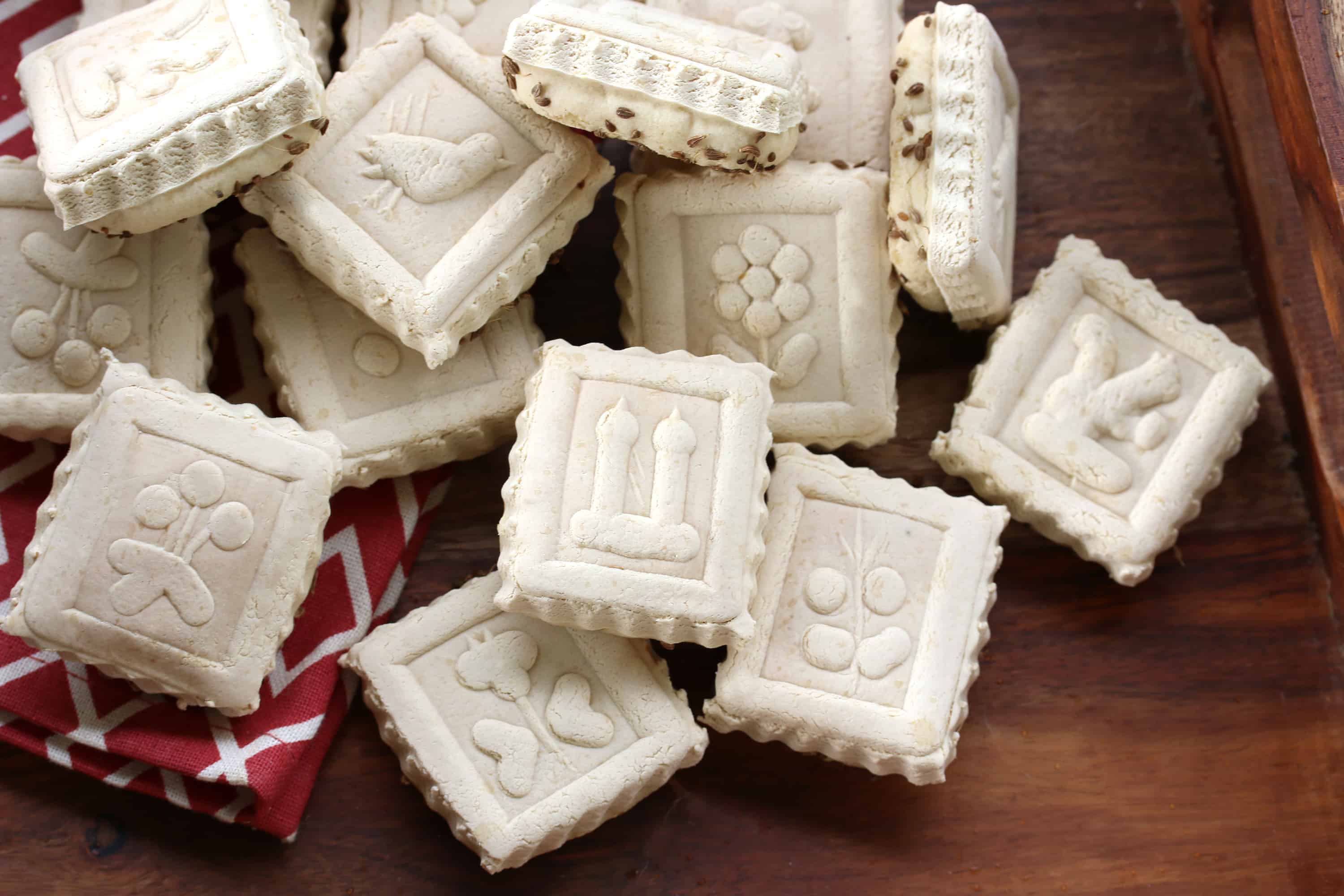
Next let’s talk about the flavor of traditional Springerle. Being made with nothing but eggs, flour and sugar they really have very little flavor. That’s where the anise comes in. There’s also the addition of the lemon zest which is optional but which we recommend because it contributes a lovely bright contrast and balance to the anise.
Key #3: Fresh Anise Seeds and Quality Pure Anise Oil
Traditionally whole anise seeds are always used. They’re dry roasted in a pan to release their oils and maximize flavor, then they’re strewn across the baking sheet before the Springerle are set on top of them. In addition to the anise seeds many German bakers will also add a few drops of pure anise oil for an added boost in flavor. We also recommend it.
The quality of your anise oil matters. It needs to taste real and it needs to be potent enough so that you only need to add a tiny bit of the oily liquid to achieve the flavor effect. So be sure to use quality 100% pure anise oil.
I use and recommend Lorann’s 100% Pure Anise Oil. It’s very potent and a few drops go a long way.
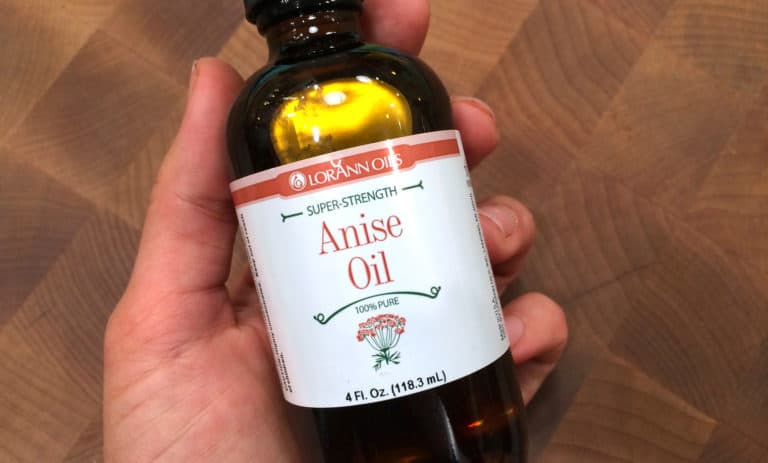
Key #4: Let the Springerle Air Dry For 24 Hours Before Baking Them
The whole purpose of Springerle are to be able to showcase their beautiful embossed designs and if you bake them right away the designs will not hold their shape or form.
In order for the embossed designs to stay in place during baking you need a dough that is super low-moisture to start and then the cookies need to be left to further dry out and develop a hardened crust on the exterior. This way the designs remain stable and unaltered during baking.
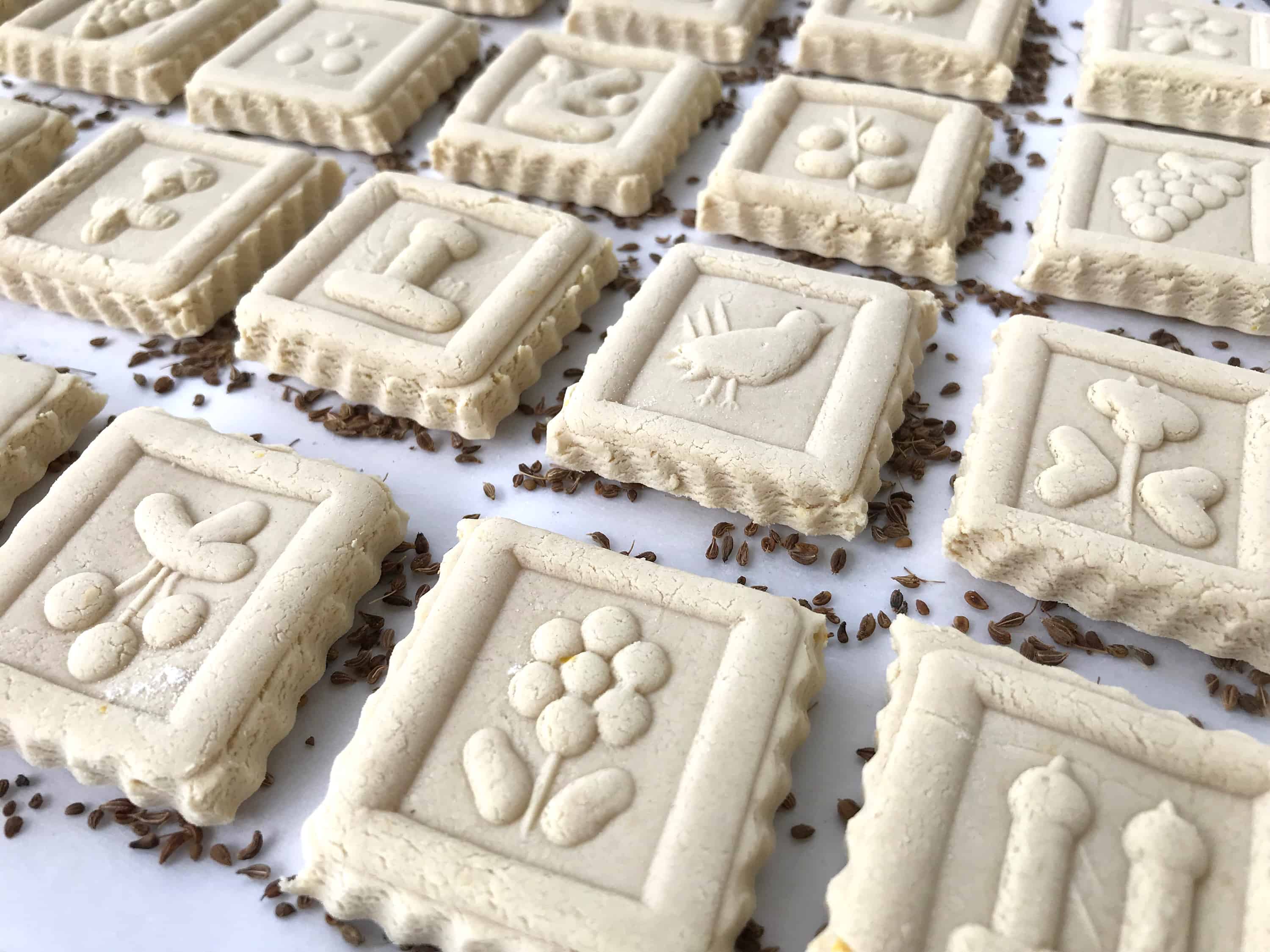
Key #5: Moisten the Bottom of Each Air-Dried Springerle Before Baking Them
The purpose of this step hearkens back to the meaning of their name, Springerle, which means “little jumpers.” Springerle rise in a particular way, creating their characteristic platform on the bottom or “feet” as they call it in Germany. In other words, they “spring up” on their “feet” while baking.
There is an important functional purpose for lightly moistening the bottom of the cookies. Once the cookies have dried for 24 hours they can have uneven moisture spots throughout. This can result in the Springerle rising more quickly on one side than the other, resulting in slanted or lop-sided cookies. To prevent that we lightly and evenly moisten the bottoms by gently pressing the cookie down on a damp cloth. That’s the key for enabling an even-leveled rise.
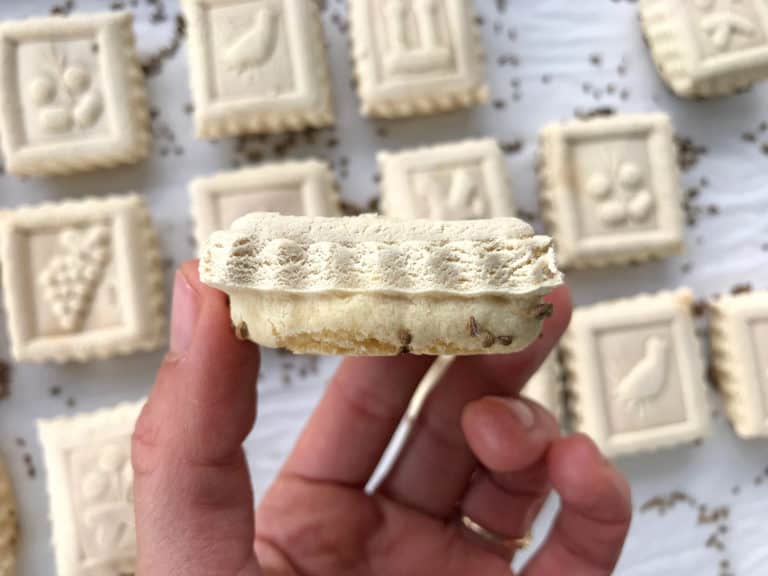
Authentic Springerle Cookies Recipe
Let’s get started!
Place the eggs in a stand mixer with the whisk attachment in place. Beat the eggs until foamy. Add the powdered sugar, a little at a time along with the vanilla sugar (or extract), anise oil and lemon zest (if using).
Once all the powdered sugar has been added continue to beat the mixture for 10 minutes. Yes, that’s 10 full minutes. The batter needs to be very loose and airy. Note: Follow the instructions on your stand mixer to give your machine a rest after the suggested amount of time so as not to overwork your mixer.
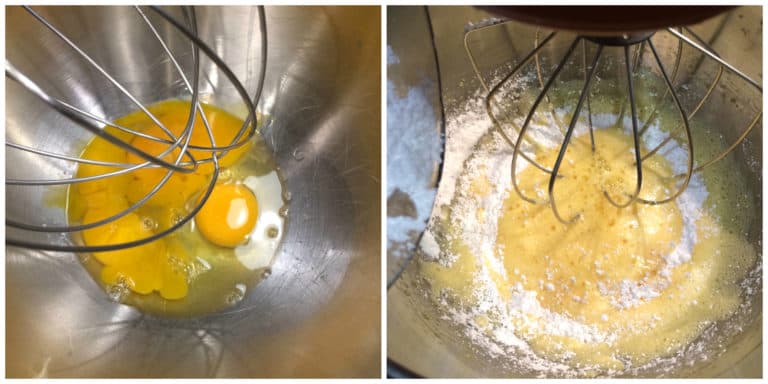
Combine the flour, baker’s ammonia and salt in a bowl. Add HALF of the flour mixture to the wet mixture along with the and beat it for a full 15 minutes.
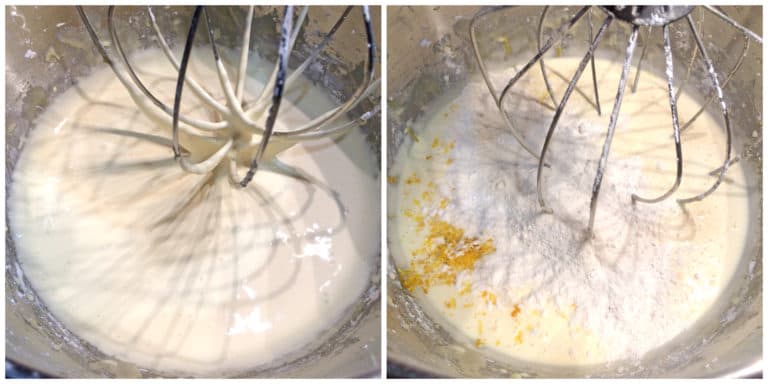
Attach the paddle attachment now. Add the remaining flour and beat for another 5 minutes.
The dough should be very soft but not wet and sticky.
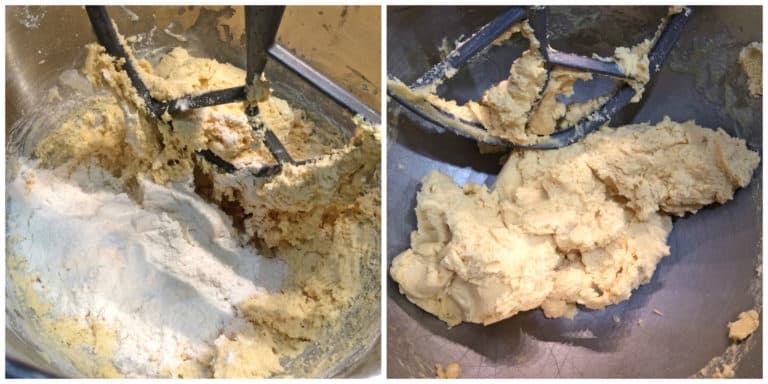
Form the dough into a ball, flatten it to an inch-thick disk, wrap it in plastic wrap and refrigerate for at least an hour or overnight.
The next day roll out the cold dough to about 1/3 inch thick (1 cm) on a floured work surface.
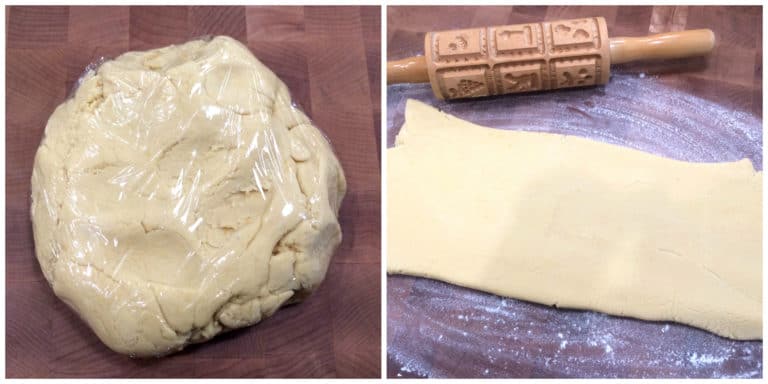
Use your molds or rolling pin to make the shapes and cut them out with sharp knife or pastry cutter. If you’re using molds lightly dust them with flour to prevent the dough from sticking.
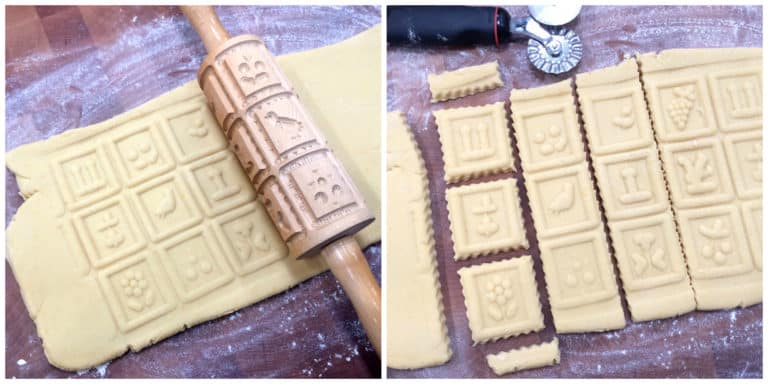
Toast the whole anise seeds in a dry pan over medium-high heat until aromatic, being careful not to let them scorch. Place the anise seeds on a lined cookie sheet, spreading them out evenly.

Lay the Springerle on top of the anise seeds on the baking sheet. Let them dry at room temperature for a full 24 hours, longer if you’re in a place with high humidity. The outside of the Springerle should be dry.
Lay a damp towel on the counter and gently press the Springerle down onto it to very lightly and evenly moisten the bottoms. Return the Springerle back to the cookie sheet.
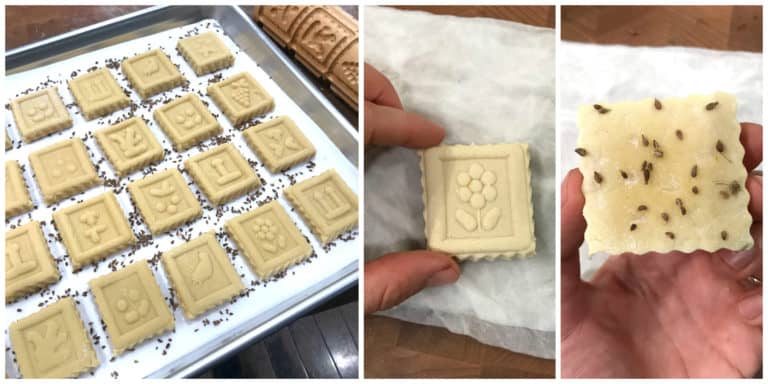
In an oven preheated to 300 degrees F with the rack positioned in the middle, bake the cookies for 20-30 minutes. Do not let the cookies turn golden, they’re supposed to stay very pale, basically the same color as when you put them in the oven.
The Springerle should have risen evenly to create their characteristic “feet” or platform underneath. Let the cookies cool off completely. They will become very hard as they cool.
Springerle are traditionally stored in airtight containers with half of an apple next to them inside the container to create a little bit of moisture to gradually soften the cookies over time. Periodically change out the apple. Once the Springerle have slightly softened up you can remove the apple and then continue storing them in the airtight container waiting for the flavor to develop.
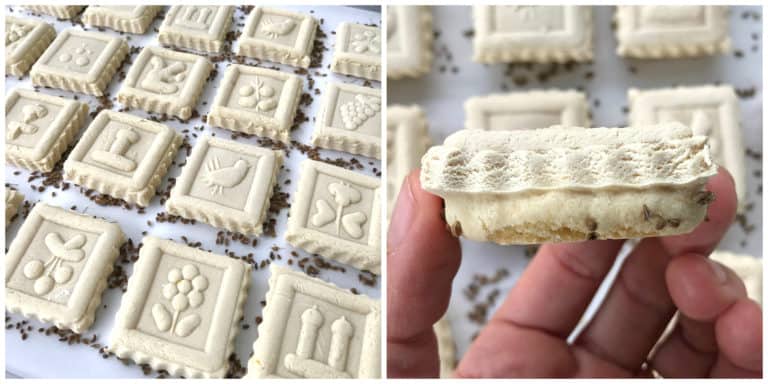
One of the nice things about Springerle is that they’re supposed to be made far in advance. So you can make them weeks before Christmas, set them aside and forget about them, and continue on with your other Christmas preparations.
Most Springerle bakers agree that waiting 3-4 weeks before eating them is best to allow the flavor and texture to develop.Enjoy these Springerle on their own or, as is tradition, enjoy them with a hot beverage and dip them.
Enjoy!
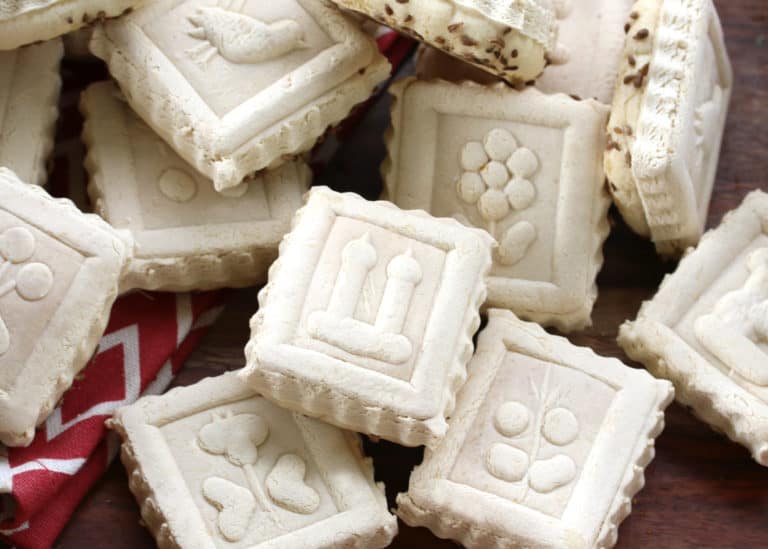
To put your molds and mold rolling pins to further use, be sure to try my traditional Speculoos cookies!
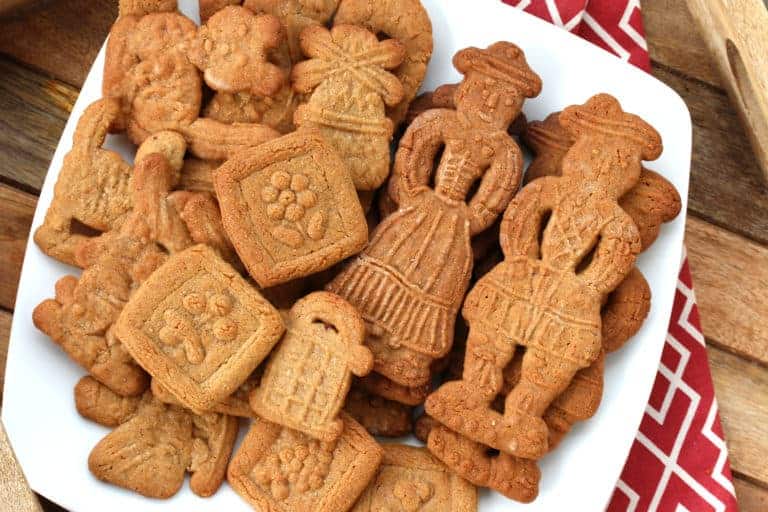
For more traditional German Christmas recipes try my:
- Stollen
- Zimtsterne
- Pfeffernüsse
- Lebkuchen
- Marzipan
- Bethmännchen
- Heidesand
- Magenbrot
- Kokosmakronen
- Marzipankartoffeln
- Haselnussmakronen
- Kinderpunsch
- Vanillekipferl
- Linserkekse
Save This Recipe
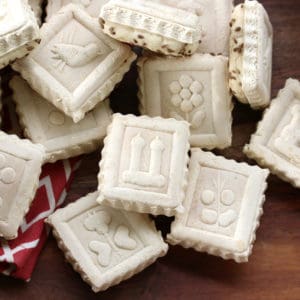
Authentic German Springerle Cookies
Equipment
Ingredients
- 3 large eggs , room temperature (the eggs must be large; if you are using medium add an additional egg)
- 3 cups powdered sugar (confectioner's sugar) (if using cups start with slightly less flour, 2-3 tablespoons, and add the rest as needed)
- 1 teaspoon quality pure vanilla extract (or 2 packets of vanilla sugar)
- 1/4 to 1/2 teaspoon quality 100% pure anise oil (not extract), how much you use depends on how strong of an anise flavor you want.
- 3 cups all-purpose flour (if measuring in cups start with slightly less flour and add the rest as needed if the dough is too soft/sticky)
- 1/4 teaspoon baker's ammonia *slightly less than 1/4 teaspoon (see blog post for explanation about baker's ammonia)
- 1/4 teaspoon salt
- zest of one lemon
- 2 tablespoons whole anise seeds
Instructions
- Place the eggs in a stand mixer with the whisk attachment in place. Beat the eggs until foamy. Add the powdered sugar, a little at a time along with the vanilla extract and anise oil.Once all the powdered sugar has been added continue to beat the mixture for 10 minutes. Yes, that's 10 full minutes, do not reduce the time. The batter needs to be very loose and airy. Note: Follow the instructions on your stand mixer to give your machine a rest after the suggested amount of time so as not to overwork your mixer.
- Combine the flour, baker's ammonia and salt in a bowl. Add HALF of the flour mixture to the wet mixture along with the lemon zest and beat it for a full 15 minutes, do not reduce the time (if the mixture is too dry for your whisk attachment, use the paddle attachment).Attach the paddle attachment, add the remaining flour and beat for another 5 minutes.The dough should be very soft but not wet and sticky. If the dough is too dry or stiff mix in a little more lightly beaten egg.Form the dough into a ball, flatten it to an inch-thick disk, wrap it in plastic wrap and refrigerate for at least an hour or overnight.
- The next day roll out the cold dough to about 1/3 inch thick (1 cm) on a floured work surface (if the dough chilled for several hours and is very firm, let it sit at room temperature until soft enough to work with). Use your molds or rolling pin to make the shapes and cut them out with sharp knife or pastry cutter. If you're using molds lightly dust them with flour to prevent the dough from sticking.Toast the whole anise seeds in a dry pan over medium-high heat until aromatic, being careful not to let them scorch. Place the anise seeds on a lined cookie sheet, spreading them out evenly.Lay the Springerle on top of the anise seeds on the baking sheet. Let them dry at room temperature for a full 24 hours, longer if you're in a place with high humidity. The outside of the Springerle should be dry.
- After the cookies have dried for at least 24 hours, lay a damp towel on the counter and gently press the Springerle down onto it to very lightly and evenly moisten the bottoms. Return the Springerle back to the cookie sheet.In an oven preheated to 300 degrees F with the rack positioned in the middle, bake the cookies for 20-30 minutes. Do not let the cookies turn golden, they're supposed to stay very pale, basically the same color as when you put them in the oven.
- The Springerle should have risen evenly to create their characteristic "feet" or platform underneath. Let the cookies cool off completely. They will become very hard as they cool. Springerle are traditionally stored in airtight containers with half of an apple next to them inside the container to create a little bit of moisture to gradually soften the cookies over time. Periodically change out the apple. Once the Springerle have slightly softened you can remove the apple and then continue storing them in the airtight container waiting for the flavor to develop.
Most Springerle bakers agree that waiting 3-4 weeks before eating them is best to allow the texture and flavor to develop.Enjoy these Springerle on their own or, as is tradition, enjoy them with a hot beverage and dip them.Makes about 34 Springerle depending on their size.
Notes
Originally published on The Daring Gourmet November 17, 2019



















My first attempt was ok. I made them too thin using a heavy rolling pin and then pressing them thinner yet with the mold plate. They weren’t much thicker then 1/4″ before baking. They got too hard and didn’t rise much. Some of the thicker ones turned out better. I will definitely omit the seeds next time. They don’t stick well to the bottom unless you do it when you wet the bottoms then dip in seeds. I did some cookies without seeds and liked them much better. I think that I ruined my Oster. It started smoking after 30 minute of run time. The last 5 minutes with the remaining flour mix was never going to happen. Too stiff, but yet a very sticky batter. I did the best I could by hand at that point.
Bravissima! Sono una cuoca professionista Italiana e la tua spiegazione è molto chiara.
Sicuramente proverò a fare i biscottini anche perché sono stata recentemte da amici in Baviera e mi hanno regalato uno stampo per springerle in legno.
Grazie, Laura, apprezzo il complimento! Happy baking!
Can the anise seeds be omitted in this recipe since there is already anise in the recipe? Thanks, Maggie
Hi Maggie, they can be omitted yes, but their inclusion is traditional for appearance, added flavor, and texture.
I followed recipe as stated but they did not spring/rise at all…
Does Ammonia go bad?
Hi Jason, yes it does. Under ideal storage conditions it still loses its potency over time and should be replaced at least once a year.
I remember making Springerle with my mom while growing up. I followed the recipe and the batter was too dry. I just whipped up an egg and then mixed it in. I just had one out of the oven and they taste good. Can’t wait to taste them after a couple of weeks!
Fantastic, Christy, and good call with the egg. I’m so glad you enjoyed them, thank you!
I just made my first batch of dough, still waiting for the cut outs to dry, but it was a bit dry and sticky. I’m wondering if you use 6X or 10 X confectioners sugar?
Hi Kristina, 10x is standard for grocery store confectioner’s sugar in the U.S. and that’s what I use. Is that what you used? Let’s wait and see how they feel after they’ve dried a bit. You may just need to extend the drying time a little longer.
love all your food !!!!
Thank you so much, Maria Luisa! <3
I have been making springerles my entire life and this was by far the most difficult recipe I have used. And I ended up with a gooey bunch of dough. I put in the fridge hoping tomorrow it will be different.
I could not even make it into a ball. Yes I followed all the instructions to a T. I used the exact amount of everything.
I will not use this recipe again. I will go back to my old one.
Haven’t tried this yet–I’m trying to get up the nerve to jump in!
Question: The rolling pins you link to don’t appear to have the designs that are on the cookies in the picture at the top of the recipe. Obviously not an important detail, but I’d like to know if a pin with those designs is available anywhere.
Hi Mark, I bought my rolling pin in Germany years ago. There aren’t many available online so I just linked to a couple of them as examples.
I made my first batch of Springerle, not perfect. I followed the directions and weighed all the ingredients. I think is was the eggs. One person in the comments said something about large eggs. I have found that large eggs are not as large as they used to be.I think the farmers grade them differently or are breeding a different type of chicken. Would you be able to amend your recipe to also give the liquid measurement or the weight of 3 eggs. I have just baked the cookies 12 od them were on the thin side and they had legs. The rest of them were 1/3″ some have legs and some are lopsided. I haven’t given up. We used to have a German bakery near us and I always bought the Springerle and Pfeffernusse at Christmas but they have long ago closed. My daughter lives outside of Philly, PA and she would send us some for Christmas. The price for last Christmas was 34 Springerle cookies for $50.00.
I will not give up
Next on my list are Speculoos
Thank you
Janet
Hi Janet, I haven’t weighed the eggs when I’ve made these so I don’t have a measurement for them but you’re probably right in that egg sizes can vary even though they’re labeled the same. Springerle are definitely finicky and getting the consistency of the dough right is really a matter of experience; having made them a few times to get a “feel” for what the proper consistency should be and whether a little extra liquid or flour needs to be added. I’m glad you’re not giving up though because the way you described your batch, even though imperfect, it sounds there was a lot of “right” going on. $50.00 is a lot to pay and homemade will be so much better! I’m happy to hear you’re making the Speculoos next – another finicky cookie that requires practice and experience but well worth the effort!
This recipe is fabulous. For three generations we used the Joy of Cooking recipe, but when I found this, and aunt and I tried it and it’s even better than JoC. We revived a family tradition, and now have some great stories about almost burning out a very old mixer doing all the steps (my new mixer was fine)!
Since first finding this recipe, I’ve hade to go gluten free, alas. So I make these for my kids, and have found a decent gluten-free springerle recipe in Jeanne Sauvage’s Gluten-Free Baking for the Holidays: 60 Recipes for Traditional Festive Treats, Chronicle Books (2012). So we can still enjoy the cookies together.
Thank you!
You state on recipe 1/4 t of bakers ammonia or littles less how much should I use thank you and should I dissolve it in liquid thank you Nadia
Hi Nadia, use just slightly less than 1/4 teaspoon and no, you do not dissolve it in liquid first.
I appreciate your note about using weights rather than volume, but there are no weight measurements given for this recipe. Can you add them?
Hi Mary, in the recipe box to the right of the list of ingredients you’ll see buttons for “US Customary” and “Metric.” Click on Metric and it will show you the ingredients by weight.
Do you brush off the anise seeds before you bake the springerle? This recipe is great!
Thank you, Wendy! No, leave the seeds on. Happy eating! :)
Just posted about blowing out the impression of the cookie. The second batch was spot on. Meaning, in my case the oven was not hot enough when I started the bake. Maybe this helps others with the same issues. Thanks!!!
Hi Eric, I’m so glad the issue was remedied with the second batch. Much like French macarons, Springerle are finicky and getting the temperature right is key and it’s something that varies from oven to oven. The ovens in my home have to be set at different temperatures for the same recipe. Even though an oven may “say” it’s at a certain, they are very commonly off (either higher or lower than they should be). Sticking a thermometer in your oven is always a great way to figure out your particular oven’s actual temperature settings.